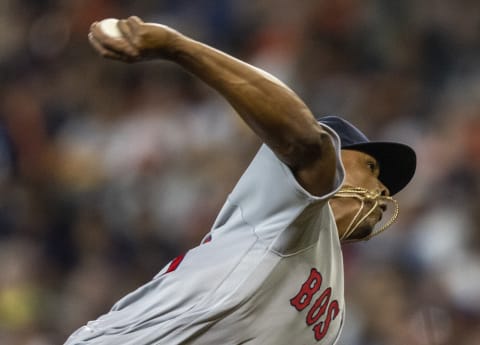3 Reasons a Rafael Devers extension has better timing than Mookie Betts situation

The timing is better for the Red Sox to extend Rafael Devers than it was when they negotiated with Mookie Betts
In the long history of the Boston Red Sox, there have been several players deserving of a big payday.
Mookie Betts is at or near the top of the list.
The Sox drafted Betts in the fifth round of the 2011 June Amateur Draft, and when he made his debut in 2014, it was clear he had some serious talent. In 2015, his first full big-league season, he received MVP votes. In 2018, he became the first player in MLB history to win a Gold Glove, Silver Slugger, batting title, MVP award, and World Series in the same year. By the time the Sox traded him to the Los Angeles Dodgers in February 2020, he’d won four consecutive Gold Gloves and three Silver Slugger awards. He’s been an All-Star every year since 2016, save for 2020, when there was no game.
Why didn’t the Sox lock a guy like that in for the remainder of his career? There are various reasons and excuses, some valid, some flimsier than a piece of paper in a rainstorm. And with the Sox preparing to re-open negotiations with Rafael Devers this fall, fans are worried it will only be a repeat of losing Betts.
But it’s worth pointing out that there’s a much better chance this deal goes through. Baseball is a team sport in that it’s not just whether a player is deserving of a lucrative contract, but whether the organization is in the optimal position to make it a successful situation, and in that regard, things in the Sox organization are aligned for a Devers deal in a way they weren’t for Betts. Timing is everything, after all.
Here are three reasons why the time is right for Devers the way it wasn’t for Betts…
Devers is younger than Betts
The Sox began making extension offers to Betts in 2018, when he was 25, the same age Devers is now, but by the time they decided to trade Betts, he was 27.
27 isn’t old by any means, but Devers already has six seasons (and several postseasons) under his belt at an even younger age. The Sox could give him a 10-year deal and he’d still be much younger at the end of it than when Betts reaches free agency as a 41-year-old in 2033.

Red Sox have more financial flexibility with Devers than they did with Betts
The Sox could’ve shelled out for Betts, kept exceeding the luxury tax, and really, done whatever they wanted to do. They’re one of baseball’s richest teams; Fenway Sports Group is approaching $10 billion in valuation. They could’ve done it. They probably should’ve.
But it would’ve cost them in several ways. Each consecutive year that a team exceeds the luxury tax threshold (CBT), the penalties become steeper. The first year, it’s a 20% tax on the amount of money spent over the threshold. In the second year, the charge rises to 30%, and 50% each year after. Teams that exceed the threshold also lose draft picks and international bonus pool money, and it affects Qualifying Offers.
With how decimated the farm system was at the time, paying Betts while being unable to rely on internal options would’ve ensured the Sox had to keep spending every year in order to plug the leaks in their roster. In trading him and David Price, they were able to unload some of Price’s record-breaking contract, affording them some breathing room. After paying overages in 2018 and 2019, they reset the tax in 2020.
Of course, the front office put the team in that tight financial situation with some reckless spending. When Betts turned down their initial extension offer following the 2018 season, former GM Dave Dombrowski gave out enormous extensions to Chris Sale and Nathan Eovaldi, instead. Sale’s extension has already proven to be one of the biggest mistakes in franchise history.
This year, the Sox are one of six franchises that have to pay the luxury tax. They’re a last-place team with the fifth-highest payroll in the game and the only one of the six with no shot at the postseason. However, at the moment, they have less than $50M in guaranteed money (excluding any club or player options) towards next year’s luxury tax payroll. They can easily ink Devers (and Xander Bogaerts) while building a better pitching staff, and they can do it all while resetting their luxury tax.

Red Sox farm system is more successful than during Betts negotiations
You might be wondering what prospects have to do with Betts or Devers. A whole lot, actually.
Unless a team plans to spend every year and pay the taxes that come with that choice, an organization with a weakened farm system can only contend for so long. 2018 was proof of that. The Sox miraculously avoided injuries for almost the entire season, but when injuries began to pile up in 2019, they had no one on the farm equipped to fill in. By 2020, they were an unwatchable mess.
This year, injuries piled up once again, but several Triple-A guys were waiting in the wings, including Brayan Bello and Triston Casas. And while there weren’t enough prospects to save the season, it was a sign of serious improvement that any prospects were able to debut, perform, and actually stick at the big-league level.
Suddenly, the Sox are faced with the pleasant problem of having too much talent, which affords them the ability to make trades, rather than relying solely on spending for free agents. The front office can combine the burgeoning farm system with smarter roster construction for next year, and put a vastly improved team on the field.
Unfortunately, that wasn’t the case in Betts’ final season in Boston. In 2019, Baseball America ranked the Sox farm system 30th, an utterly blighted organization, two years after they’d ranked 14th. It’s improved every year since, and this year, jumped from 21st all the way to 11th. With the emergence of players such as Ceddanne Rafael, they could be a top-10 farm system next year.
With Devers, the Sox have the financial flexibility to build around him at the big-league level this offseason as they continue to develop talent to fortify the club or be used for trades.